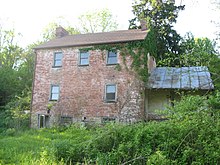Martin Marmon House
The Martin Marmon House is a historic home near Zanesfield in the Jefferson Township of Logan County , Ohio in the United States . It was built around 1820 by pioneer Martin Marmon and is one of the best-preserved examples of Quaker architecture .
history
Martin Marmon was a Quaker from North Carolina . He moved with his two sons and their families from Kentucky to central Ohio in 1805 , where they were the first settlers in Jefferson Township after Isaac Zane . He had married a Shawnee woman and lived in the area. This move was typical of the southern Quakers, who moved north in large numbers to turn away from the slavery system in the southern states. Their new home was very close to the Shawnee Territory, just a little south of the border line established by the Treaty of Greenvillehad been set. Ten years after their arrival, Martin bought the land on which he settled from his brother Robert, who lived a little further east. On this land he built his brick house , which he will live in for the rest of his life.
The Martin Marmon House was the residence of one of the area's leading figures at the time. After Logan County was separated from Champaign County 's territory in 1818 , Marmon held several offices in the newly formed county: he was treasurer of Jefferson Township for 25 years and Logan County's four years, plus five years county sheriff . The Marmon brothers also stood out in the practice of religion, as they founded the Goshen Meeting of Friends in 1807, which today as Goshen Friends Church is the oldest surviving parish in Logan County.
After Martin Marmon's death, his farm was sold to David Springate, a British from Kent who settled in 1864. The farm at that time was 153 acres (62 hectares ). Today the house is part of the Marmon Valley Farms, a Christian institution. It was last used as a residential building in 1971. The Marmon House was listed on the Ohio Historic Inventory in 1984 and on the National Register of Historic Places on February 20, 1986 . It is one of four Logan County's residential buildings to be on the registry.
architecture
In addition to its role in the settlement of the Marmon Valley, the Marmon House is significant as a rare example of Quaker architecture that no longer exists and is considered the best-preserved Quaker house in this part of Ohio. It is typical of a building from that period in terms of its stone foundation, the two and a half floors made of brick , the arrangement of the windows and the position of the chimneys . Although four other brick residential buildings were built in the area around the same time, none of them preserved the integrity of Marmon House's architecture; the Robert Marmon House has been rebuilt, two more have been destroyed and the fourth is a different architectural style. The Martin Marmon House has nevertheless undergone a few changes: a summer kitchen that was added to the east end of the house at an unspecified time, the installation of running water on the ground floor and the replacement of the original roof with a tin roof. The property also has a shed and a cold store over a spring. The latter has been changed significantly, but the shed is sufficiently historical that it is listed as a contributing property . The location of the house is a bit unusual. Although the US Highway 33 , which has been developed like a freeway, runs in the immediate vicinity and the house is only about 30 m away from County Road 153, it is still at the foot of a hill in the middle of dense woodland.
literature
- Allan Noble: Wood, Brick, and Stone: The North American Settlement Landscape ( English ). U of Mass P, Amherst 1984.
Individual evidence
- ↑ a b c d e f g h i Rachel Barber: National Register of Historic Places Inventory / Nomination: Martin Marmon House ( English ). National Park Service, January 1985.
- ^ A b c d e William Henry Perrin, JH Battle: History of Logan County and Ohio ( English ). OL Baskin, Chicago 1880, pp. 241, 398-399, 770.
- ^ A b Rachel Barber: Ohio Historic Inventory Nomination: Robert Marmon House ( English ). Ohio Historical Society, February 1984.
- ^ A b c d Rachel Barber: Ohio Historic Inventory Nomination: Martin Marmon House ( English ). Ohio Historical Society, May 1984.
Coordinates: 40 ° 19 ′ 40 ″ N , 83 ° 40 ′ 0 ″ W.
